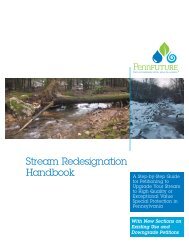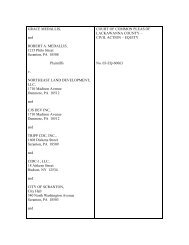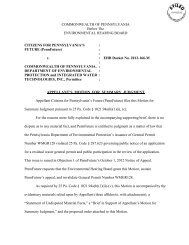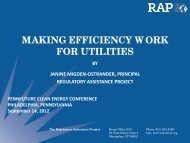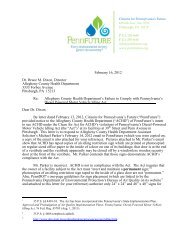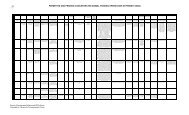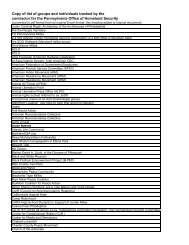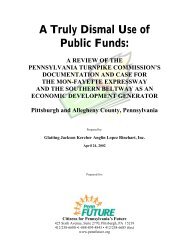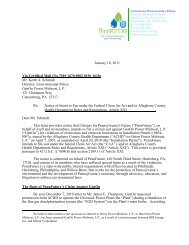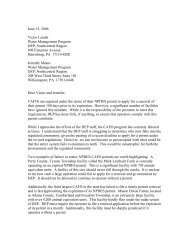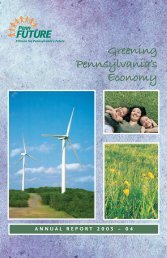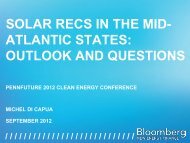A Review of the Pennsylvania Phosphorus Index ... - PennFuture
A Review of the Pennsylvania Phosphorus Index ... - PennFuture
A Review of the Pennsylvania Phosphorus Index ... - PennFuture
Create successful ePaper yourself
Turn your PDF publications into a flip-book with our unique Google optimized e-Paper software.
The P-<strong>Index</strong> source factor uses a Mehlich-3 soil test to estimate <strong>the</strong> amount <strong>of</strong> P at risk forrun<strong>of</strong>f from <strong>the</strong> soil. <strong>Phosphorus</strong> availability from fertilizer depends on <strong>the</strong> amount <strong>of</strong> fertilizerand <strong>the</strong> manner in which it is applied, whe<strong>the</strong>r applied in spring or fall and whe<strong>the</strong>r and when itis incorporated into <strong>the</strong> soil. The P available from manure, like fertilizer, is dependent on whenapplied and whe<strong>the</strong>r incorporated but also includes a P source coefficient (PSC.) The PSC canbe taken from a chart provided by <strong>the</strong> state (e.g., in <strong>the</strong> P-<strong>Index</strong> Fact Sheet), known as <strong>the</strong> Bookvalue. Alternatively, <strong>the</strong> PSC can be determined by submitting <strong>the</strong> manure sample for a waterextractableP (WEP) analysis. The WEP test option was added to Version 2 <strong>of</strong> <strong>the</strong> PA P-<strong>Index</strong>.The Part A screening test was also modified in Version 2 with <strong>the</strong> addition <strong>of</strong> two conditions; <strong>the</strong>Special Protection Waters, and <strong>the</strong> significant change in farm management. The conversion toVersion 2 was described as a natural evolution <strong>of</strong> <strong>the</strong> P-<strong>Index</strong>, recommended by a group <strong>of</strong>scientists at <strong>the</strong> USDA-ARS Pasture Systems and Watershed Management Research Unit atUniversity Park, PA and <strong>the</strong> <strong>Pennsylvania</strong> State University College <strong>of</strong> Agricultural Sciences(Beegle. pers. comm., Beegle et al 2009.) This group conducts an ongoing review <strong>of</strong> <strong>the</strong> P-<strong>Index</strong>calculation. While <strong>the</strong> use <strong>of</strong> a WEP analysis-based PSC likely lowers <strong>the</strong> P-<strong>Index</strong>, <strong>the</strong> additionalPart A conditions likely result in more farms calculating a P-<strong>Index</strong>. Dr. Beegle mentioned thatPA was considering a third version <strong>of</strong> <strong>the</strong> P-<strong>Index</strong> which might come out this year. A preview <strong>of</strong>potential recommended adjustments in <strong>the</strong> P-<strong>Index</strong> might be presaged in <strong>the</strong> SERA-17recommendations on <strong>the</strong> revisions to <strong>the</strong> 590 Nutrient Management Standard (Sharpley et al2011.)Assessments <strong>of</strong> <strong>the</strong> Affect <strong>of</strong> <strong>the</strong> <strong>Phosphorus</strong> <strong>Index</strong> on <strong>Pennsylvania</strong> AgricultureDuring <strong>the</strong> development <strong>of</strong> <strong>the</strong> PA P-<strong>Index</strong>, efforts were made to assess <strong>the</strong> impact onagriculture. In a statewide survey <strong>of</strong> over 220,000 soil samples collected in PA between 1996and 2001, Kogelmann et al (2002) found 4.8% exceeded 200 ppm P and 1.5% exceeded 300ppm P. Several counties located in <strong>the</strong> sou<strong>the</strong>astern part <strong>of</strong> <strong>the</strong> state had a higher than averagepercentage <strong>of</strong> excessively high soil P samples. Lancaster, Schuylkill and Montgomery Countieshad <strong>the</strong> highest proportion above 200 ppm P (17.6%, 16.7% and 16.1%, respectively.) Additionalhotspots were noted in Wyoming, Wayne and Lackawanna Counties in <strong>the</strong> nor<strong>the</strong>ast and ErieCounty in <strong>the</strong> northwest (Kogelmann et al 2004.) Also <strong>of</strong> note, statewide, 48% <strong>of</strong> <strong>the</strong> soilsamples had soil P test values <strong>of</strong> 50 ppm P or more. The optimum range <strong>of</strong> soil P for crops is 30– 50 ppm P. Lancaster County had 81% <strong>of</strong> soil samples exceeding crop P needs. Seventeen out<strong>of</strong> <strong>the</strong> 67 counties statewide had greater than 60% <strong>of</strong> soil samples exceeded crop P needs. Thissuggests <strong>the</strong> possible widespread over fertilization <strong>of</strong> P. Not surprisingly, a positive relationshipwas found between animal density and high soil P concentrations.Besides high soil P concentrations and animal densities, Kogelmann et al (2002) also found thata greater percentage <strong>of</strong> <strong>the</strong> agricultural lands in <strong>the</strong> north and south-central parts <strong>of</strong> <strong>the</strong> statewere in close proximity to streams (within 150 feet), elevating <strong>the</strong> risk <strong>of</strong> P loss to streams inthose areas. Modeling <strong>of</strong> run<strong>of</strong>f in hilly areas indicated that nearly all <strong>the</strong> P run<strong>of</strong>f wasgenerated from about 10% <strong>of</strong> <strong>the</strong> watershed areas, within about 98 to 197 feet <strong>of</strong> <strong>the</strong> channel(Kogelmann et al 2004). These areas, known as variable source areas (VSA’s), are likely <strong>the</strong>Page 2



